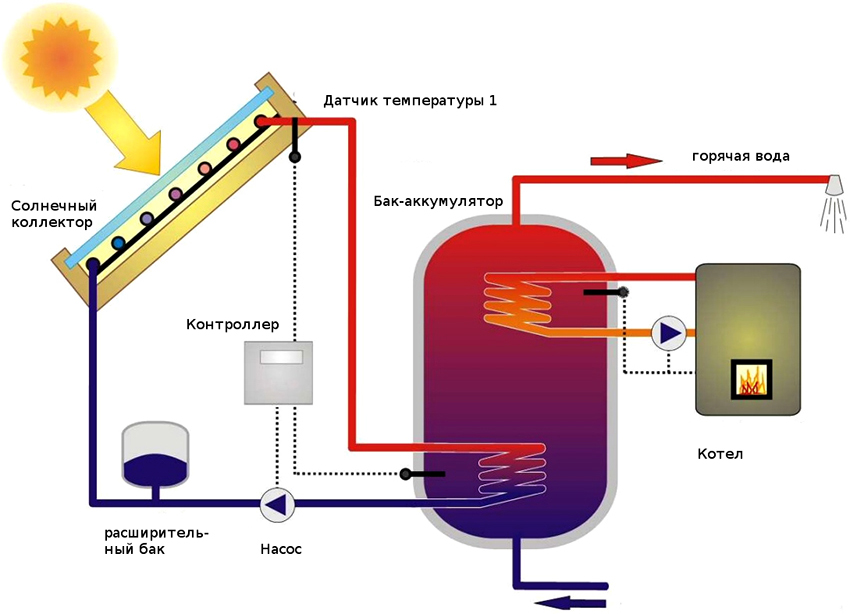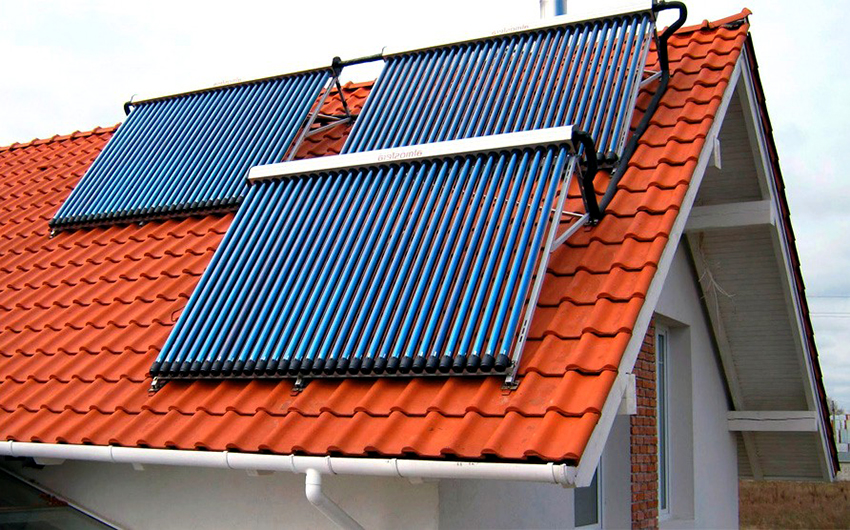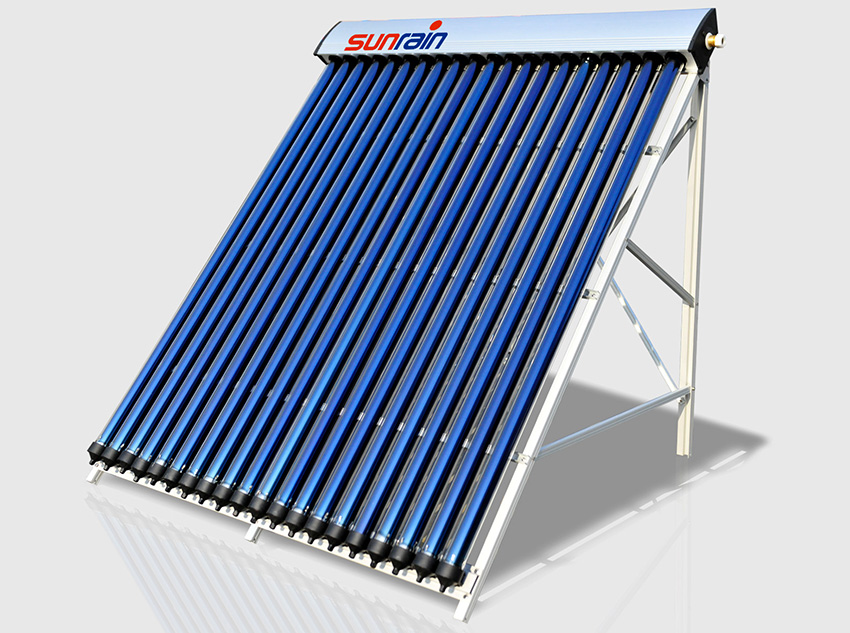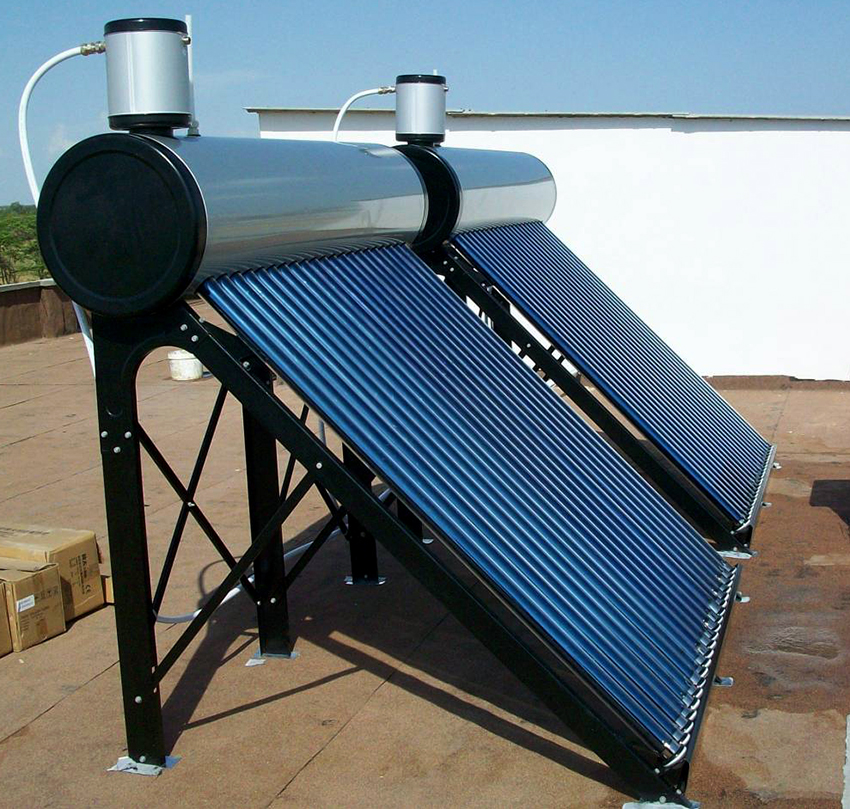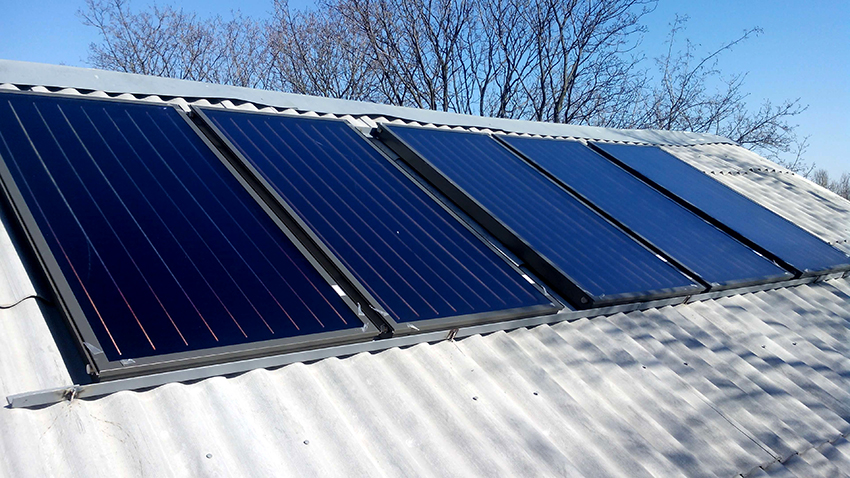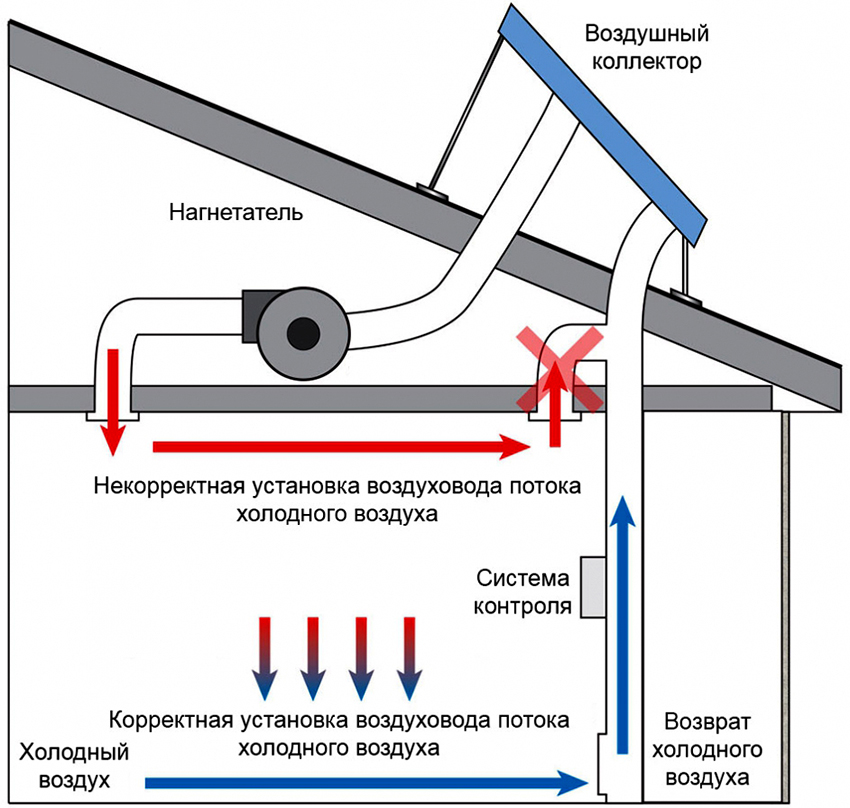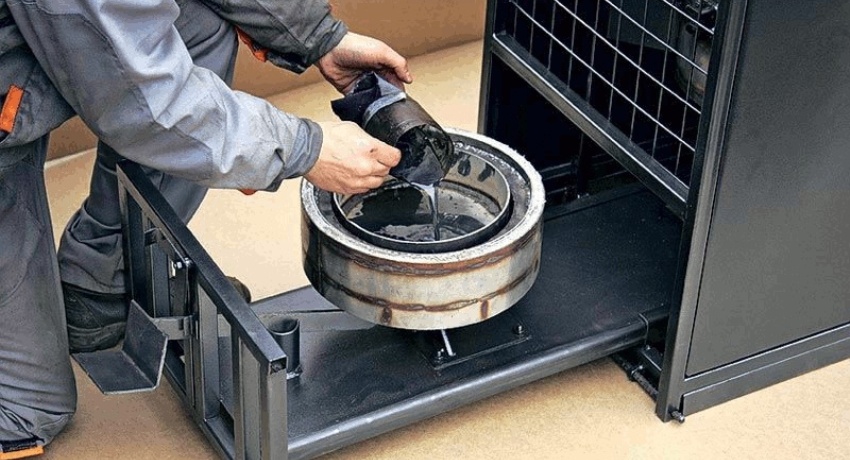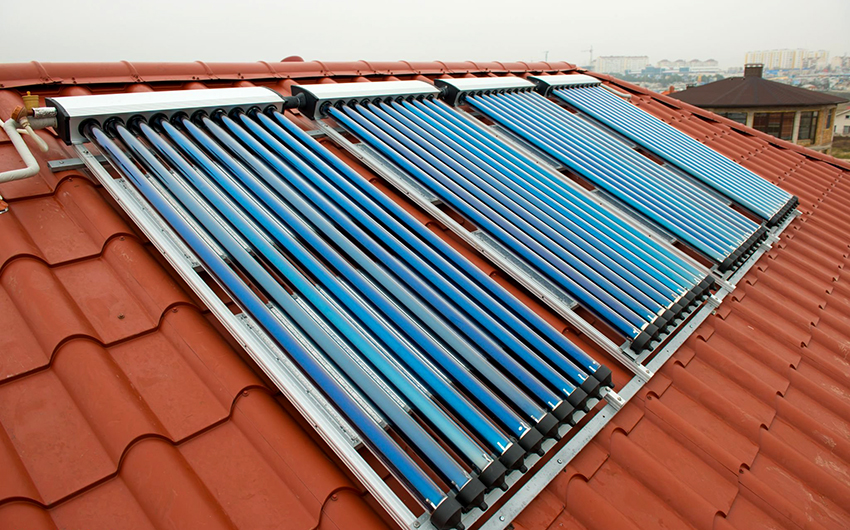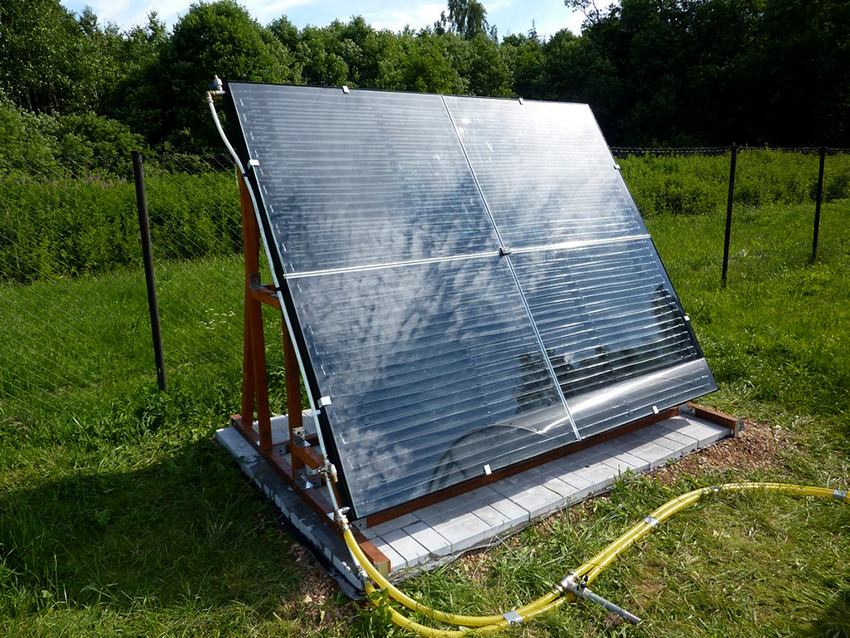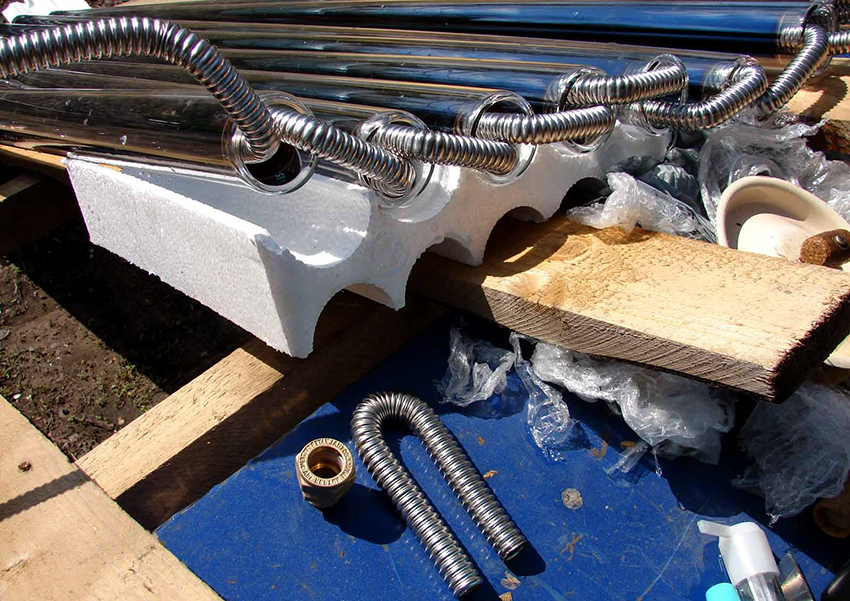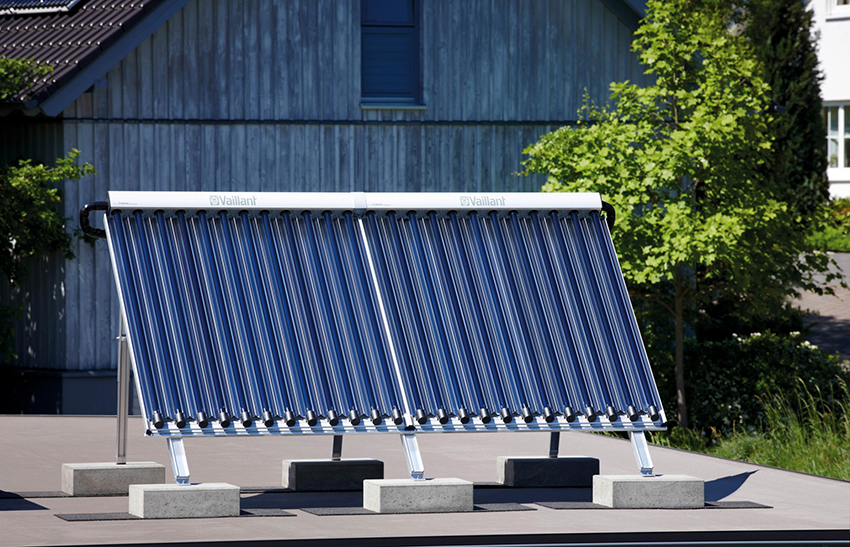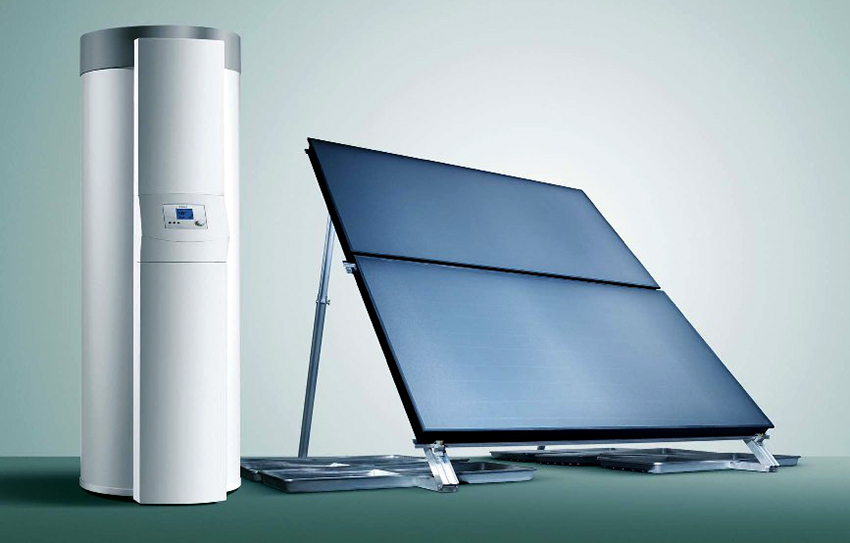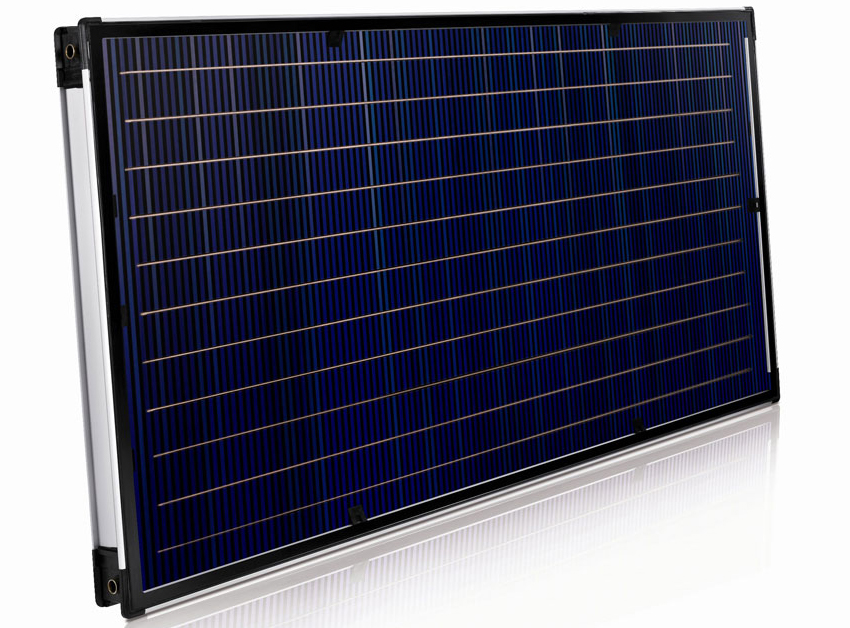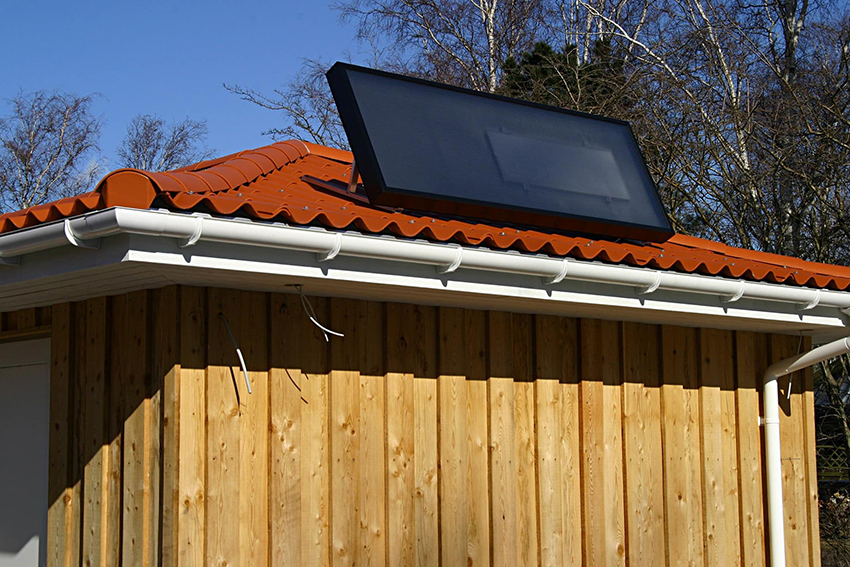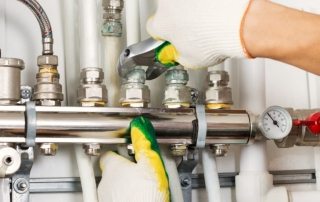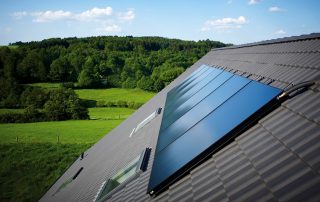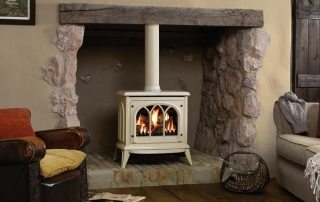A large amount of solar radiation comes to the surface of the earth every day, which is mostly not used. However, it is a free source of heat that can be converted into energy suitable for human needs. Solar collectors for home heating are ideal for this task. You can learn about the principle of their operation, what are the differences between them and how effective they are, from this article.
Content [Hide]
- 1 What is a solar collector and how it works
- 2 Advantages and disadvantages of solar collectors for water heating
- 3 Solar collectors for home heating: types of installations
- 4 Design features of a flat solar collector
- 5 Characteristics of a vacuum solar collector for home heating in winter
- 6 Solar air collector for heating: product features
- 7 Requirements for materials for making a homemade solar collector
- 8 Making a flat solar collector with your own hands
- 9 DIY air solar collector options
- 10 Solar collector for home heating: reviews and recommendations for choosing a device
- 11 Sequence of solar installation for solar heating
- 12 Domestic manufacturers of solar collectors for home
- 13 Review of popular models of solar collectors for heating
What is a solar collector and how it works
A solar thermal collector is a technical device that can convert solar energy into thermal energy. It is used to obtain hot water, which can later be used for various needs. The main difference between solar collectors and other variants of similar technology lies in the principle of changing the density of water during heating. Cold masses displace the heated water stream upward, so there is no need to use additional pumping equipment.
The principle of operation of the device is as follows. The solar energy is absorbed in the receiving device, which can be copper or glass surfaces in dark or black color. Such materials are characterized by good energy absorption properties.
Solar water heaters are conveniently located on the roof, where there is a lot of space and where the maximum amount of sunlight gets. Here, such devices do not take up useful space and do not interfere with anyone. Then the heat from the storage device is transferred to the coolant tank.This can be water, antifreeze or other liquid used in the heating system.
In most cases, a mixture of 40% glycol and 60% distilled water is used. The heating medium, which is heated to a certain temperature, is supplied to the radiators through a piping system.
The direction of movement of water in the system can be changed thanks to the mixer. The cooled and warm water is constantly replacing each other. This natural circulation is due to the expansion of warm water, which rises, forcing cold water into the heating tank.
This heating system must be equipped with a thermal insulation layer with a thickness of at least 25-30 cm, which will ensure its efficient and stable operation. It is better to use a rectangular reservoir as a storage tank for the coolant. A backup heating element can be located here. It will automatically turn on in operation when weather conditions are created that do not contribute to the heating of the coolant to the required temperature.
Advantages and disadvantages of solar collectors for water heating
In summer, solar collectors are able to fully provide the house with hot water. In the off-season, such an alternative heating system can reduce the load on the gas boiler, which will reduce gas consumption, while reducing financial costs.
Important! In winter, solar collectors are ineffective due to the small amount of solar radiation.
The collector acts as an additional source of free heat, thereby reducing dependence on gas. In the summer, you will not need financial costs to obtain hot water.
Installation of the solar collector does not require a permit. When choosing equipment, you should carefully study all available information and consult with a knowledgeable seller. The installation of the system must be entrusted to a specialist or performed independently with certain skills and abilities in the field of plumbing. The system operation period is on average about 15 years. During this time, you can use free solar heat for your own needs.
The disadvantages of such a system include large financial costs that will need to be incurred when purchasing solar collectors. The average cost of one element is $ 500-1000. The system, consisting of two collectors and assembled on a turnkey basis, will cost between $ 2300-3000.
The intensity of solar energy differs at different times of the year, so solar collectors cannot be used as the only source of heat. For the system to work, you will need a storage tank, the purchase of which will entail an increase in the cost of arranging a water heating system from the sun.
Solar collectors for home heating: types of installations
By design, solar collectors can be flat or vacuum. The latter option is the more common type, which is characterized by ease of installation, high efficiency, and the ability to provide the entire house with the required amount of heat. A vacuum solar collector for heating a house, the price of which exceeds the cost of a flat product, is represented by a complex design that can be used to fully heat a room and heat water in any season of the year.
There is a special type of installation called a concentrator collector.It is a system of parabolic reflectors, which are located on one curved surface, where sunlight is concentrated at certain points. To obtain the maximum effect, it is necessary to change the position of the device following the movement of the sun, which can be in two planes.
Depending on the coolant, liquid and air structures are distinguished. In the first case, distilled water or antifreeze is used, and in the second, heated air.
According to the type of application of the coolant, passive and active systems are distinguished. In the first version, the solar collector is used in conjunction with a storage tank. Such a system is acceptable for hot water supply and is not equipped with additional engineering elements. The active option involves the installation of a solar collector and other technical devices, such as a pump, storage tank, safety valves, and additional heating medium heating devices. Such a system can be used for hot water supply and for heating a house.
Heat transfer can be indirect or direct. The first option assumes the presence of a storage tank, in which the heat energy received by the external circuit from solar radiation is transferred to the internal circuit circulating in the heating and hot water systems. In direct-flow systems that are used for hot water supply, the circulation of water in the collector circuit occurs under the influence of a temperature difference and due to the presence of additional elements in the form of valves and taps.
Classification of solar collectors for heating according to the heating medium temperature
Air or water solar collectors for heating a house can be classified according to the degree of heating of its working organs and heat carrier. Depending on this criterion, a distinction is made between low-, medium- and high-temperature installations. Low-temperature options are capable of heating the coolant up to 50 ° C. Such heat collectors are used to heat water in showers in summer, in irrigation tanks, to create comfortable conditions on cool spring-autumn evenings.
Medium temperature systems provide heating of the coolant up to 80 ° C. Such installations are used for space heating, for swimming pools. Solar collectors of this category are most advisable to install when arranging a private house. High-temperature systems are capable of heating the coolant to a temperature of 250-300 ° C. These devices are recommended for industrial use. They are used to heat commercial buildings, production halls and other technological premises.
High temperature systems involve a complex process of converting and transferring heat energy. The structures have impressive dimensions that require a lot of free space for their installation. The manufacturing process of the system is very laborious and costly, which is associated with the use of specialized equipment. You will not be able to perform this option on your own.
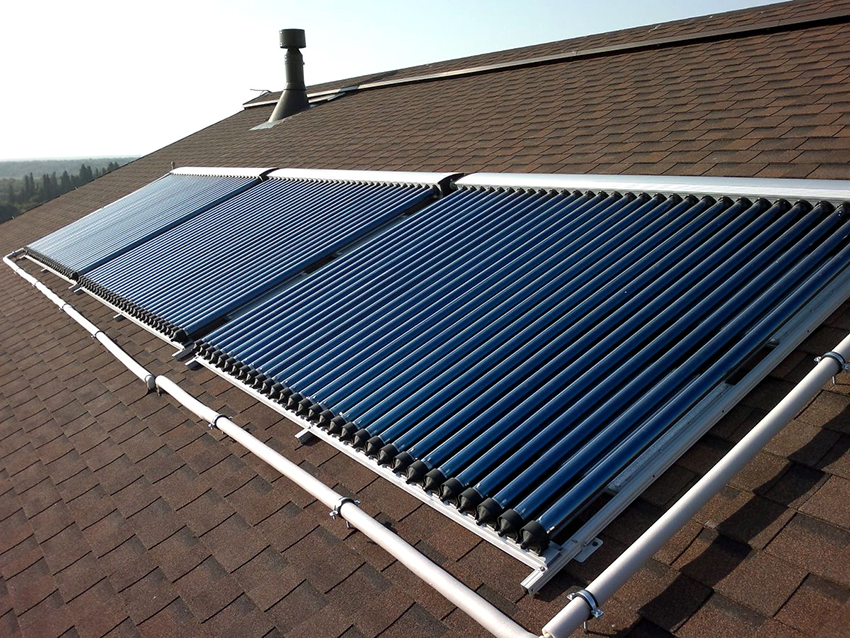
According to the heating temperature, the collectors are classified into low, medium and high temperature
Design features of a flat solar collector
The most popular option is, according to numerous reviews, a flat-type solar collector that can be made by hand. Such a system is effective for organizing hot water supply during the warm season. In winter, the efficiency of the device is very low.
The collector body is flat, square or rectangular. It is made of metal or other material with a high thermal conductivity.The product is coated with a dark paint to improve the absorption properties. Inside the body there is a plate in which there is a coil made of small section copper tube. The coolant circulates through the tubes. To minimize heat loss, a heat-insulating material is laid inside the case.
To prevent debris from getting into the device case, it is closed from above with a glass or polycarbonate cover, which can increase heating. For efficient operation of the collector, it must be periodically wiped clean from dirt and dust.
The flat solar collector is recommended to be installed in the southern regions, where this option is characterized by the best indicators of price and efficiency. Such a device is distinguished by the ability to self-cleaning, high efficiency in the summer and low cost.
However, flat collectors are characterized by significant heat losses that arise due to the design features of the device. Such a system has low efficiency in the spring and autumn period. The structure is characterized by high windage, which causes the risk of damage during the operation of its elements.
Characteristics of a vacuum solar collector for home heating in winter
A solar vacuum collector is a rather complex device. The main working element is an expensive light-absorbing bulb with a transparent surface, in which the tube is located. The work is based on the principle of a thermos. The vacuum bulb allows sunlight to pass into the inner tube, where there is no air, which allows you to save up to 95% of heat.
Helpful advice! It is impractical to make a vacuum solar collector with your own hands, which is due to the specifics of the production technology.
The lower part of the inner vacuum tube for the solar collector is occupied by antifreeze, which turns into a gaseous state when heated. In its upper part, heat is transferred to a collector with a coolant. At the same time, the antifreeze cools and condenses, returning to its original state.
The vacuum solar collector is characterized by a high efficiency value in low light conditions and temperatures below -37 ° C. It was specially designed for northern latitudes and can function in the absence of direct solar radiation. For effective operation, the structure needs constant care, which consists in cleaning its surface from dirt.
Important! The manifold must be mounted at a specific angle as indicated in the installation instructions for the device.
The main disadvantage is the high construction cost. If at least one tube fails, the repair will be problematic, since all products are mounted sequentially.
Solar air collector for heating: product features
Air solar collectors use air as a heating medium for heating. The device can be made in two versions: in the form of a flat corrugated or perforated panel or a system of metal pipes.
The simplest option is a flat absorber consisting of a panel and a tube with inlet and outlet nozzles. All elements are located in a box, the back and side walls of which are covered with thermal insulation. The panel is made of copper or aluminum and painted black. It is covered with a transparent protective surface made of glass, plastic or polycarbonate.
The air entering the panel is heated by contact with the metal. The ribs on the surface of the product contribute to an increase in heat transfer.For maximum efficiency, the structure should be installed on the south side of the house with high quality insulation. The system can be organized with natural or forced circulation of the coolant. The latter option involves the installation of a fan.
Related article:
Waste oil boiler: a reliable and budget option for heating a room
Principle of operation and distinctive features. Varieties of the device. How to make it yourself. Manufacturers and popular models.
The system with natural circulation is used extremely rarely, which is associated with the slow movement of air masses, as a result of which significant heat losses occur. Air solar collectors Solar Fox can operate at a temperature of 25 ° C, while for a solar water system, the optimal value is 45 ° C. Such structures can only be used for air heating of the house. The collectors are not able to heat the water. The devices are characterized by low efficiency, differ in very impressive dimensions, however, they have a simple design, are easy to install and affordable.
Helpful advice! To increase the efficiency of air solar systems, the collectors can be built into the walls of the south orientation during the construction phase of the house.
The thermal conductivity of air is significantly lower than these indicators of water, which affects the efficient operation of the system. All butt joints must be carefully insulated to avoid heat loss. Despite the existing disadvantages, the solar air collector copes well with the task of heating indoor air with a temperature difference between inside and outside of 15-17 ° C.
Requirements for materials for making a homemade solar collector
For the manufacture of the frame of the solar collector for self-heating, plywood, wooden beams, OSB boards or other similar options are used. Alternatively, you can use an aluminum or steel profile with inserts of similar materials, which will give the structure strength and reliability. However, such a housing would be expensive.
Materials must meet the requirements for structures that are located outdoors. Since the average operating life of a solar collector is 20-30 years, it is necessary that the materials have high performance characteristics that will remain unchanged throughout the entire life of the installation.
The wood for the hull must be treated with water-polymer compounds and covered with paint and varnish emulsions. The steel profile must be reliably protected against corrosion.
To make a heliostat absorber with your own hands, use the available materials at hand. The coil can be made of rigid PVC pipe with fittings, flexible HDPE pipe, bent copper or metal tube. The heat exchanger of an old refrigerator is suitable for the absorber. Also, the element can be made from aluminum cans or plastic bottles. The main selection criterion is the thermal conductivity of the material.
To prevent heat loss, the case should be insulated on all sides. For these purposes, mineral wool or foam is mainly used. The foil version of the insulation has proven itself well, which will provide not only thermal insulation, but also the reflection of the sun's rays from the surface.
Important! In the foam insulation layer, grooves must be made for laying the coil.
The heat exchanger is covered with a protective surface, which can be tempered glass or monolithic polycarbonate. The material should have a corrugated surface, not a smooth surface.
Making a flat solar collector with your own hands
At the first stage, the solar collector for heating is calculated based on the area of the room. Its dimensions are also determined by the level of sun activity in a given region, the location of the house, and the characteristics of the area.
The collector body is made of wood or glass. Old glazed windows can be used. To create an absorber, aluminum or copper tubes, a coiled rubber hose, and steel flat batteries are suitable. You can create a manifold from black polypropylene pipes.
Heat-insulating material in the form of foam or mineral wool is placed on the bottom of the case. Further, the entire area is covered with a metal sheet of thin steel or aluminum to enhance the effect of heat transfer.
Coil pipes are mounted on top, which are attached to the metal sheet with brackets. Its ends are brought out. The surface of the structure is covered with impact-resistant tempered glass or transparent polycarbonate, leaving a gap of 10-15 cm for good heat transfer. The storage tank is protected with heat insulating material or painted black. A heating element is connected to it, from which the piping of the house heating system is laid.
Important! All butt joints must be reliably sealed.
DIY air solar collector options
Making a traditional solar air collector for home heating with your own hands begins with the creation of a frame from wooden planks. The back and end walls should be insulated with mineral wool. The housing is fixed to the wall. All gaps must be insulated with polyurethane foam. On the sides, holes are made for branch pipes for the inlet and outlet of air masses. The outer elements are securely wrapped with thermal insulation material.
As an absorber, a perforated aluminum metal sheet is used, which is characterized by high thermal conductivity and low cost. To increase the selective qualities, it is covered with black paint. A sheet of glass or polycarbonate is laid on top.
Important! The degree of heating is determined by the dimensions of the solar panel.
The absorber can be made of rectangular water pipes, which are installed on an aluminum sheet and fixed to it with mounting tape and self-tapping screws. The back wall of the wooden case is insulated with mineral wool, and the side ones - with expanded polystyrene. The pipes are painted black and covered with a tempered glass or polycarbonate sheet.
An even simpler design is made of corrugated board. The frame is made of wooden blocks. An outlet hole is made in the bottom. A corrugated board with many holes along the entire area of the product is laid on the beam, which will ensure the flow of air.
A good solution is to build an air collector on the window. This is a fairly effective option that allows you to heat the room well. The frame is made of aluminum frames and is attached to the window in the form of a mosquito net. The back wall is made of a sheet of aluminum, in which holes are made in the lower (for the intake of cold air) and in the upper (for the removal of warm air) parts. The role of the absorber can also be played by black foil, which is covered with a protective PVC film.
Solar collector for home heating: reviews and recommendations for choosing a device
When choosing a solar collector, some nuances should be considered. Flat models are more durable than other varieties. However, such structures are not suitable for repair.A minor breakdown can destroy the entire absorption system, which leads to the cost of purchasing a new one. You can save money by making a flat solar water heater with your own hands, which heats the coolant 30-40 ° C above the ambient temperature.
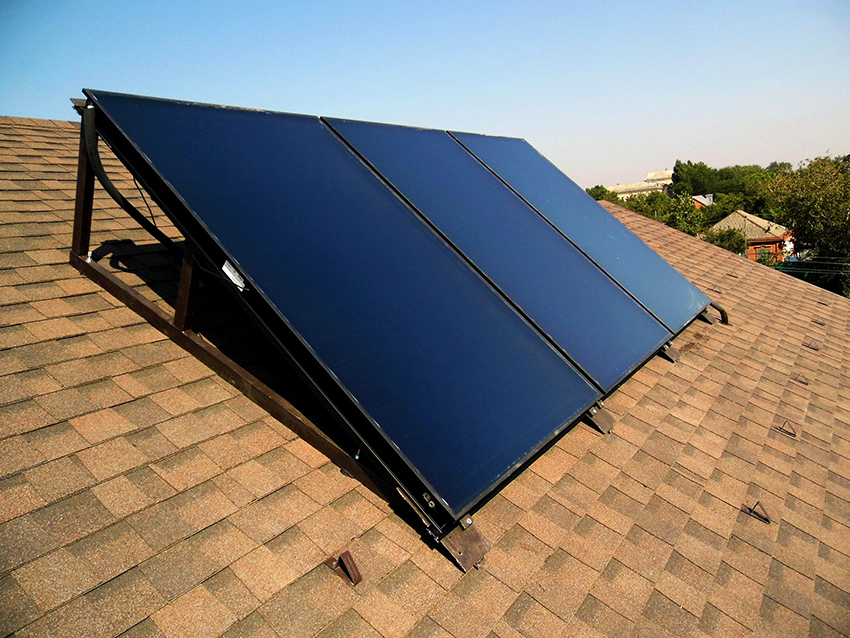
When choosing a collector, you need to take into account that flat models are more durable, but cannot be repaired
Vacuum solar heating systems are very sensitive to external influences, more susceptible to damage, which is associated with the fragility of hollow tubes. However, if one of the flasks fails, it can be replaced with a new one. This collector is much more efficient in winter than the flat version, since it provides heating in a wider range and is able to maintain the temperature for a long time.
The performance of the vacuum manifold depends on the size of the tubes. The shorter they are, the less heat is produced. The best option is a system with several flasks 2 m long and 6 cm wide. To ensure effective thermogenesis, a straight or U-shaped insert must be located in the inside of the flask.
Air options have a simple design, rarely need repair, and are able to withstand very low temperatures. Their service life exceeds the period of operation of other systems. However, they do not heat up the room very much.
Helpful advice! Before purchasing the system, it is necessary to perform the calculation of the solar collector with the participation of a qualified specialist in this field of activity.
It is important to choose the right place to install the system. Do-it-yourself solar water heater must be located on the south side or with a deviation from it by 30 °. Measures should be provided to drain precipitation in winter. The device can be positioned vertically, which eliminates the problems associated with cleaning the collector from snow. However, this situation will negatively affect the efficiency of the heater.
Sequence of solar installation for solar heating
After buying or making a solar collector for home heating with your own hands, you can start installing it.
Installation begins with the installation of a storage tank with a capacity of 20-40 liters. It is also possible to use several small tanks that are connected in series with pipes. The tank should be insulated to avoid rapid loss of thermal energy. The storage tank is located at the highest point. It should be borne in mind that when the system is filled with liquid, the structure will have significant weight, which will require strengthening the floor at its location.
Next, a do-it-yourself installation of a solar collector for heating water is performed, which is located on the southern side of the building at an angle relative to the horizon of 35-45 °. Then the system is tied with pipes, which is necessary to obtain a closed hydraulic circuit. For this, inch or half-inch elements are used. Parts of a smaller diameter are used to organize the pressure head of the system. Pipes should be insulated to reduce the likelihood of heat loss.
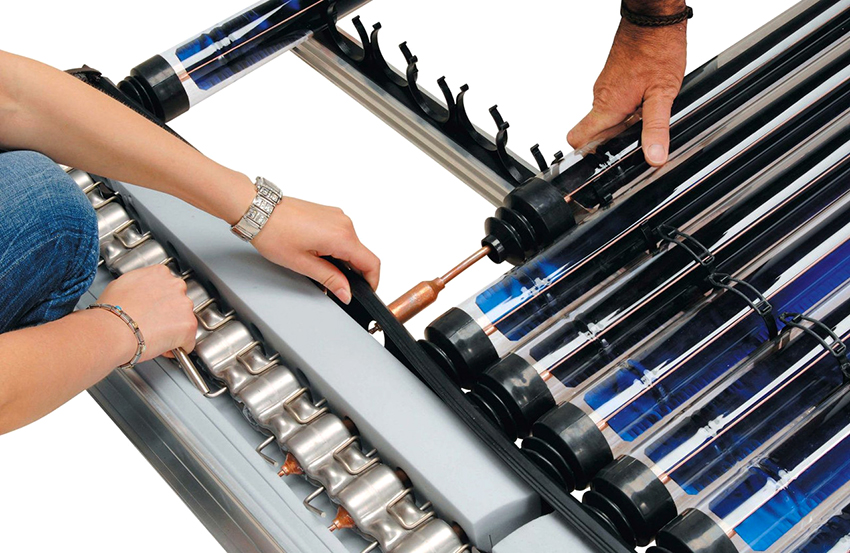
In order for the collector to work efficiently, it is necessary to correctly assemble and install the structure
Important! The efficient operation of the heating collector depends on the tightness of all connection nodes.
Upon completion of installation, a system test is performed. Its filling takes place through a pipe in the lower part of the collector, which eliminates the possibility of air congestion. The coolant enters the storage tank until the optimum level is reached, which is controlled by a float valve. The heated liquid will rise in the pre-chamber and enter the heating system.Natural circulation continues until the temperature of the liquid entering the radiator and the one that leaves the collector is equalized.
When arranging the hydraulic system, it is envisaged to install shut-off valves that prevent the return circulation of the coolant to the reservoir from the collector. This phenomenon occurs when the ambient temperature drops, which is typical for the evening or night time.
Domestic manufacturers of solar collectors for home
A popular manufacturer of solar collectors is the New Pole company, which offers a wide range of models at affordable prices. A special place is occupied by flat devices made of aluminum. The heating medium circulates through copper pipes equipped with double insulating protection, which ensures efficient operation of the system at low temperatures.
Home heating equipment can be purchased complete with a storage tank, temperature controller and circulation pump. The average price of a solar collector will be 20-22 thousand rubles.
Another successful manufacturer of solar-to-thermal converters is AltEnergia, which produces flat and vacuum collectors. The first version of the product can be supplied together with a boiler with a volume of 200-500 liters, which works on the principle of indirect heating. Vacuum collectors are equipped with storage tanks for 100-1000 l and circulation pumps.
Important! Products from AltEnergia are certified in Germany.
A flat device will cost about 13 thousand rubles. The price of a vacuum solar collector will be 35-50 thousand rubles.
The domestic manufacturer ANDI Group specializes in the manufacture of vacuum-type collectors. The main feature of the product is their ability to adapt to difficult weather conditions. Collectors are capable of converting energy even on cloudy days. Each bulb has a three-layer coating, which ensures maximum absorption of solar radiation. You can buy a solar collector for an average of 25-35 thousand rubles.
NPO Mashinostroyenia manufactures a range of solar collectors that are distinguished by simple modification, functionality and affordable cost. The latest technologies are used in the manufacture of products. A distinctive feature of the collectors is the presence of a multilayer absorber, which is applied to the absorber by magnetic spraying. This layer contributes to the maximum capture and retention of solar energy, due to which the device efficiency is 85-90%. You can buy a solar system for 15-20 thousand rubles.
Review of popular models of solar collectors for heating
A popular model of a flat solar collector is a domestically produced Sokol-Effect A product. Such an installation can be used all year round. The panel size is 2.06 m². The absorber is made of aluminum. Absorbs up to 95% of solar energy. Heat loss is 5%. The average productivity of the plant is 125 liters. The liquid can be heated up to 50 ° C. The price of a solar heating collector is 17 thousand rubles.
Another efficient flat model is the FPC-2200 manifold. The adsorber is represented by an aluminum panel that is capable of absorbing up to 94% of solar radiation. The maximum unit pressure is 1 MPa. The active area of the panel is 2.1 m². The solar collector is considered to be a high-temperature unit that heats the coolant to 135 ° C. The cost of the device is 28 thousand rubles.
The best vacuum solar collector is the HH-SCH-12 model.The device consists of 12 flasks 1.8 m long and 5.8 cm in diameter. The collector efficiency is 92%. The working area of the installation is 1.5 m². This solar collector is considered the ideal solution for split systems. To increase productivity, you can combine several of these devices in series. This model costs 27 thousand rubles.
The Solarventi SV3 model is popular among air solar collectors. Such a device can work offline. The collector is used for heating residential, warehouse and technical premises up to 25 m². A full cycle of air exchange takes place within 2 hours. The system efficiency is 57%. The collector heats the coolant to 15 ° C. Due to its low weight of 6 kg, the device can be fixed vertically to the wall. The cost of such a collector is 40 thousand rubles.
The solar collector is one of the most popular and affordable alternative heat sources for centralized hot water supply and home heating. Such a technical device can be purchased ready-made or made independently from scrap materials, which will save finances. The choice of a specific type of product should be after studying all the advantages and disadvantages of the design that must be considered for a particular situation.

